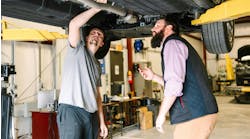The way Steve Pierce sees it, when it comes to collision repair, there’s no point in reinventing the wheel. That sentiment is exactly why, six years after launching his own shop, he decided to join a collision repair franchise.
“The easiest way to explain it is that most people open a business and find a way to create a wheel and [the franchise] already developed the wheel,” he says. “They just teach you how to spin it around. They have it down to a point where, this is how you’re going to make money doing it.”
Pierce’s Helena, Mont., shop officially became CARSTAR Summit Collision Center at the beginning of 2016 and he’s seen numerous benefits in joining a franchise. Above all, he says the biggest advantage is getting some of the benefits of being an MSO while still being able to own and operate his own business.
He does note, however, that joining a collision repair franchise is a big decision and one that should not be taken lightly. Both Pierce and two other franchise shop owners—Ken Miller, owner of Fix Auto Silverdale in Silverdale, Wash., and Craig Mullett of Maaco of North Canton in North Canton, Ohio—say there are several factors that should be considered before deciding if a franchise is right for your shop. All three owners outline the factors they considered and the steps they took to become a franchise shop.
The Benefits of Franchising
Before joining a franchise, the owners agree it’s important to understand the true benefits of being part of a franchise. Mullett sums up the biggest two benefits as purchasing power and marketing.
“It’s all about marketing and providing the products or the raw materials to the franchisees,” he says. “They have their own marketing organization that takes care of making commercials and actually making purchases and the media buys.”
Mullett says the savings from the group purchasing power are a huge difference from the retail price he would get as an independent shop. When it comes to the marketing, although Mullett is responsible for marketing at the local level, he says that Maaco’s unique approach to marketing has helped him diversify his customer base.
“They market to the trade organizations and retail and somewhat to the insurance,” he says. “Having that retail leg of the company is certainly beneficial to us. This year, it’s been a very light winter and the insurance work is way down but our retail work is holding steady.”
Pierce echoes that sentiment of having an extra hand solving problems.
“You call them if you have a problem and they figure out who to get a hold of,” he says. “It kind of takes part of the headache away from being the shop owner.”
Finally, Miller says that brand recognition was another factor that heavily influenced his decision.
1) Decide if a franchise is right for you.
The first step of this process, Miller says, is evaluating if joining a franchise is the right move for your shop. Although he had some experience with franchises in the past (he worked for another Fix Auto franchise for 10 years), upon opening his own shop, Miller says he was looking for a way to hold a competitive edge.
In addition, Miller says he was interested in the sharing of metrics and best practices with other franchise shops. The operational benefits, he says, appealed to him as a way to run a tighter business.
“I decided I really liked how the process things were done there and how they helped out with training, moving things into the future instead of idling and watching how things happen,” Pierce says.
Mullett does caution that a franchise is not right for every shop, particularly if you’re not committed to training or continuous improvement.
“If you’re going to make the move, I would say you’re going to be investing a lot in training and becoming a top flight shop,” he says. “Otherwise it’s probably not worth it. If you don’t have that commitment to being the best in your area, then regardless of what moniker is hanging out on your building, stay with your existing plan.”
2) Pick the right franchise.
There are a number of franchise businesses in the collision repair space and Miller says the next step was deciding which one was the right fit for his shop. Because he had worked for a Fix Auto shop in the past, he was already familiar with the business model and says that familiarity was a benefit. He says he also wanted to get a feel for the reputation of the different franchises and wanted to make sure that the other shops in the network were of high quality.
To do that, Miller talked to other franchise shop owners to hear their experiences. Pierce and Mullett did the same thing, conducting site visits and talking to other shop owners.
“For me, it was about where the limits were with what Fix has control of and where the shops have control. It’s important to know what voice you have and where you need to step back and be part of a group,” Miller says.
He also considered the different advantages unique to each franchise. CARSTAR, for example, has an aluminum repair recognition program, and Fix Auto has a national call center.
In addition, he says he looked at the renewal rate for the franchisees. Fix Auto, for example, had a 100 percent renewal rate at the end of its five-year renewal period.
For Mullett, he also considered what he wanted the relationship with his franchise to look like. He decided that in his case, he wanted a partner that could help him get the shop up and running and then be relatively hands off.
“How much interface do you actually end up getting with your franchise? Are they someone who is there weekly, monthly, every six months? What’s the ongoing contact and relationships?” he says. “In our particular case, after the first six months, it’s very limited. They let you run your shop the way you want to run your shop.”
3) Talk to your staff about the changes.
Miller says that joining a franchise can be a difficult transition for staff, but that it’s key to keep employees in the loop.
“They have to trust the owner and the decision they made,” he says. “What we explained to them is that it’s targeting. Our shop will have a better system and we are entering into an agreement to make ourselves better, in terms of marketing and insulating and competing with MSOs.”
He says that during the process, Fix came in and hosted a staff dinner where they explained the process and conducted some training. Miller also took that time to dispel common myths surrounding what it means to join a franchise.
Pierce’s staff had a similar reaction and he says he made an effort to listen to the feedback and put out fires. His staff didn’t want to be micromanaged, he says, and there were some growing pains.
“No one likes change,” he says. “They want to show up every day and do the same thing. I don’t want them to show up every day and do the same thing. I want them to be productive.”
4) Consider the requirements.
Before joining a franchise, Miller says there are a number of requirements that must be met, regardless of the franchise you’re looking to join. The franchises are looking to see if a shop is metrics driven and has the technology needed, such as an electronic management system. Other requirements could include adding an estimating system, VeriFacts certification, I-CAR Gold Class certification, community involvement and regular training for employees.
Prior to joining Fix Auto, Miller was put on the franchises’ management system for 60–90 days, which compared his shop to other Fix locations. Miller also attended some of the company’s owner’s meetings, where owners come together to share best practices.
Mullett says that the average time it takes to go through the joining process for Maaco is 6–8 months, but his shop was able to do it in three months. He says that the requirements included showing sales figures, rehabbing the building, filling out the necessary paperwork and attending a four-week training process.
Miller says another factor was the pay structure associated with the franchise. Each franchise has a base initiation fee, in addition to a recurring-fee structure that varies by company (a percentage of all monthly business, volume of work, fees per claim, etc.). Miller says that most contracts are a five-year commitment with an option to renew after that.
5) Make the changes.
After signing the contracts, the final step was beginning to make the changes associated with the look of the business.
Miller was provided a brand transition guide that outlined the changes to take place over a 180-day period. That included the look of the business, including signage, wallpaper in the reception room and uniforms. Maaco and CARSTAR have similar guides.
Similar to Mullett, Miller was also flown to San Diego to attend a required owner’s onboarding training, where Fix explained what to expect, what some of the reporting programs look like and the process when a customer calls the call center. During that time, he was also assigned an account manager who acted as his single point of contact throughout the transition.




